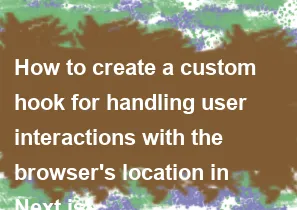How to create a custom hook for handling user interactions with the browser's location in Next.js

To create a custom hook for handling user interactions with the browser's location in Next.js, you can utilize the useRouter hook provided by Next.js along with React's useState hook. Here's a step-by-step guide:
Install Dependencies: Ensure you have Next.js installed and set up in your project.
Create the Custom Hook: You can create a custom hook named
useLocation:
javascript// hooks/useLocation.js
import { useRouter } from 'next/router';
import { useEffect, useState } from 'react';
const useLocation = () => {
const router = useRouter();
const [location, setLocation] = useState(router.asPath);
useEffect(() => {
const handleRouteChange = (url) => {
setLocation(url);
};
// Subscribe to router events
router.events.on('routeChangeComplete', handleRouteChange);
// Unsubscribe from router events when component unmounts
return () => {
router.events.off('routeChangeComplete', handleRouteChange);
};
}, [router.events]);
return location;
};
export default useLocation;
- Use the Custom Hook in Your Components: You can now import and use the
useLocationhook in your Next.js components:
javascript// components/MyComponent.js
import React from 'react';
import useLocation from '../hooks/useLocation';
const MyComponent = () => {
const location = useLocation();
return (
<div>
Current Location: {location}
</div>
);
};
export default MyComponent;
- Testing: You can now use
MyComponentin your pages or other components. It will automatically update whenever the browser's location changes.
This custom hook subscribes to router events provided by Next.js and updates the location state whenever the route changes. It then returns the current location, which can be used in components to reactively update UI based on the browser's location.
-
Popular Post
- How to optimize for Google's About This Result feature for local businesses
- How to implement multi-language support in an Express.js application
- How to handle and optimize for changes in mobile search behavior
- How to handle CORS in a Node.js application
- How to use Vue.js with a UI framework (e.g., Vuetify, Element UI)
- How to configure Laravel Telescope for monitoring and profiling API requests
- How to create a command-line tool using the Commander.js library in Node.js
- How to implement code splitting in a React.js application
- How to use the AWS SDK for Node.js to interact with various AWS services
- How to use the Node.js Stream API for efficient data processing
- How to implement a cookie parser middleware in Node.js
- How to implement WebSockets for real-time communication in React
-
Latest Post
- How to implement a dynamic form with dynamic field styling based on user input in Next.js
- How to create a custom hook for handling user interactions with the browser's device motion in Next.js
- How to create a custom hook for handling user interactions with the browser's battery status in Next.js
- How to implement a dynamic form with dynamic field visibility based on user input in Next.js
- How to implement a dynamic form with real-time collaboration features in Next.js
- How to create a custom hook for handling user interactions with the browser's media devices in Next.js
- How to use the useSWRInfinite hook for paginating data with a custom loading indicator in Next.js
- How to create a custom hook for handling user interactions with the browser's network status in Next.js
- How to create a custom hook for handling user interactions with the browser's location in Next.js
- How to implement a dynamic form with multi-language support in Next.js
- How to create a custom hook for handling user interactions with the browser's ambient light sensor in Next.js
- How to use the useHover hook for creating interactive image zoom effects in Next.js